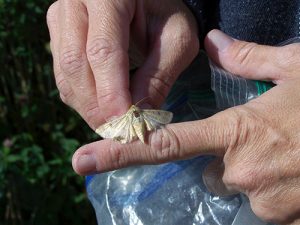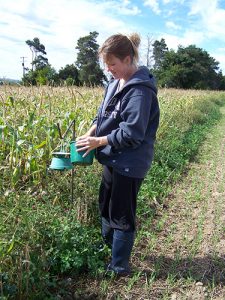Got a sweet tooth for sweet corn? You’re in good company. So should you hear rumors on the wind about wormy sweet corn – or field corn or dry beans (the kind you put in your soup kettle) and you’re curious about what’s behind them, here’s the scoop:
The western bean cutworm (just call it “WBC”), a recent invasive, is making waves in the midwestern and eastern corn belts. This pest made landfall in New York’s million-plus acres of field corn in 2010, its numbers spiraling ever upward since. This year, though, has been a record-breaker. WBC has become a pest we can count on for a long time to come.
To cope with WBC, the New York State IPM Program coordinates a “pheromone trap network” for WBC in field corn; in dry beans too. A second IPM trap network focuses on sweet corn, though it also traps for WBC in beans.
But what is a pheromone and how does the network work? Think of pheromones as scents that insects send wafting on the wind to alert others in their tribe that something important is happening – and the time to act is now. In this case, pheromones are the “come hither” perfumes female moths use to advertise for mates.


Trapped — one more male out looking for a date.
But lures imbued with chemical replicates of pheromones can intercept males on their quest, dooming them to a very different fate. IPM scouts strategically place special trap buckets around corn and bean fields. Each contains a “kill strip” treated with an insecticide. Farmers, Extension educators, and crop consultants check the buckets each week to count their take.
And though it’s their larvae – the worms – that give WBC its name, here we’re counting the adults; in this case, moths.


It’s traps — and scouts — like these that do the job.
This year the two networks combined have caught more than 35,500 moths – far more than in any other year. Those in the know, know – this is not good. WBC is a sneaky critter. It even eats its eggshells as soon as it hatches, removing evidence that it’s out and about. Meanwhile, trap network numbers can vary considerably from county to county; even from farm to farm. Regardless, when armed with counts in their area farmers know when it’s time to ramp up scouting their fields. Because once they’ve reached threshold – the IPM “do-something” point – it’s time to act.
Why wait till a field reaches threshold? Because sprays are expensive – both to the farmers’ bottom line and the environment. Because time is money too; spending it needlessly out on a rig does no favors. Because treating only at need is one very good way to keep all these costs as low as can be.
Because – it’s what IPM is here for.
–















